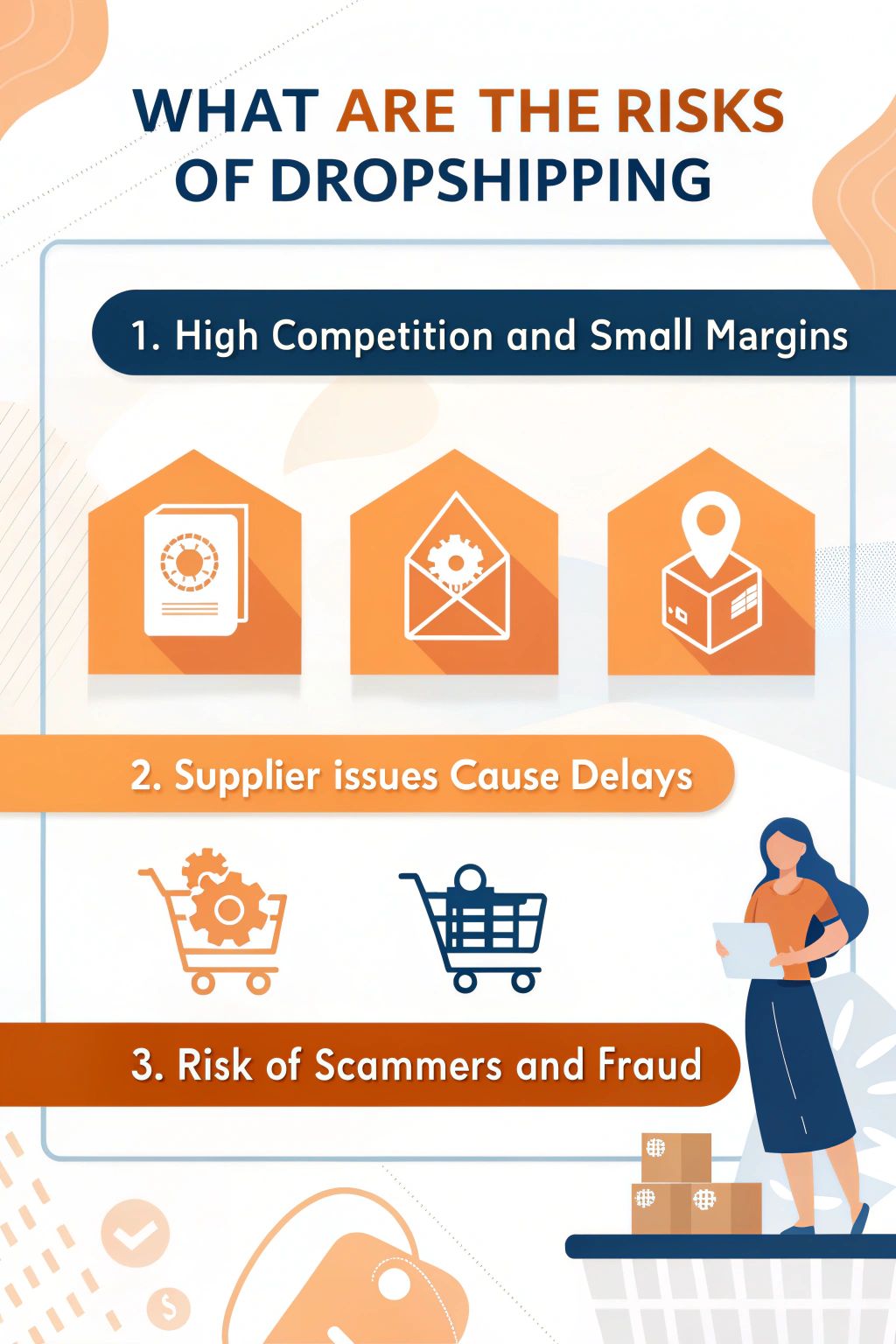Starting a dropshipping business sounds easy. You don’t need to keep products, manage a warehouse, or handle shipping yourself. But many new dropshippers face big surprises once they get started.
From unhappy customers to late deliveries, the risks can add up fast.
One common issue is control—or lack of it. Sellers rely on suppliers for inventory and quality checks. If something goes wrong, it’s hard to fix quickly. This blog breaks down the top risks of dropshipping and how you can avoid them.
Keep reading to protect your business from costly mistakes!
Key Takeaways
- Dropshipping has high competition and low-profit margins, making it hard to stand out or earn well.
- Relying on suppliers for inventory, quality checks, and shipping causes delays and customer issues.
- Scammers and fake suppliers can lead to financial loss by delivering poor products or disappearing with money.
- Picking the wrong platform or niche limits sales due to fewer options or overcrowded markets.
- Legal problems like tax compliance and unreliable payment systems hurt trust and increase risks.

Intense Competition

Dropshipping has low barriers to entry, creating a crowded market. Many sellers join quickly through platforms like Shopify and WooCommerce. Automated tools make it easy for new competitors to start selling right away.
The broad product selection adds to the fierce rivalry. Similar items from different brands lead to price wars as sellers undercut each other. SmokeDrop’s wide catalog of smoke products further intensifies this competition.
This can push profit margins lower, making it harder for dropshippers to stand out in such a competitive marketplace.
### Next Section: 3. Low-Profit Margins.
Low-Profit Margins
Low-profit margins make dropshipping risky. Wholesalers set prices, so sellers have little room to adjust. Shipping costs often eat into modest profit margins, especially with free shipping offers.
Returns and chargebacks add more losses since sellers cover these costs themselves.
Market saturation lowers small profit margins too. High competition forces sellers to price products lower just to stay competitive. Niches like smoke products suffer from tight profit margins due to this constant price battle.
Lack of Control Over the Supply Chain
You depend heavily on suppliers, which can lead to unexpected problems like delays or poor-quality products—keep reading to learn how this impacts your business.
Dependency on suppliers
Dropshippers rely on suppliers for product availability and order fulfillment. If a supplier runs out of stock or delays shipping, the store’s reputation can take a hit. Selling out-of-stock products frustrates customers and causes cancellations.
Timely delivery depends heavily on supplier performance. A single delay can harm customer satisfaction and lower trust in the brand. Poor inventory management from suppliers may lead to lost sales and unhappy shoppers.
Quality control challenges
Suppliers control product quality. This can cause problems. Products from different brands might not match in consistency. Faulty items may slip through because suppliers lack strong checks.
Inventory accuracy adds more issues. Relying on multiple suppliers makes it tough to track stock levels. Some products could show as available but are actually out-of-stock, leading to unhappy customers.
Reliable updates and order fulfillment often fall behind, hurting trust with buyers.
Sudden Stock Shortages
Stock discrepancies can hurt sales. Products may sell out quickly, leaving customers frustrated. Automated inventory sync helps avoid this issue. It ensures updates to stock levels happen fast across online stores.
Platforms like SmokeDrop offer flexible solutions. They provide a wide product catalog and no minimum order limits. Dropshippers can manage orders efficiently while reducing the risk of unexpected stock deficits.
Scammers and Fraudulent Suppliers
Dishonest merchants can harm a dropshipping business. Scam artists often pose as legitimate suppliers but fail to deliver products or send counterfeit goods. These fake vendors may disappear after taking payments, leaving businesses with upset customers and financial losses.
Dropshippers must be cautious of warning signs like vague contact details, upfront fees, or unusually low prices. Working with fraudulent distributors risks legal issues and tarnished reputations.
Swindlers steal funds and waste valuable time that could be spent expanding the business.
Choosing the Wrong Niche
Falling for fake suppliers hurts profits, but a wrong niche can hurt even more. A bad niche limits customer interest and drops sales potential. Picking one without enough demand leaves products untouched, collecting dust instead of dollars.
Crowded niches cause big issues too—competition pushes profit margins lower and lower. Ignoring market trends blocks growth and stalls the business. Overly saturated markets make it hard to stand out from others selling the same thing.
Poor choices also complicate marketing, making it tough to attract an audience that cares about your products.
Platform-Related Challenges
Picking the wrong platform can cause big problems for your business—find out how to choose wisely!
Choosing the wrong platform
Choosing the wrong platform can cause big problems for dropshippers. Platforms with limited supplier options restrict product variety and brand exposure, hurting sales. Some don’t offer smooth integration, which slows down operations and creates order management issues.
Poor inventory tools lead to selling out-of-stock items, angering customers. Lack of automation for order fulfillment and tracking adds more mistakes. A limited product catalog on certain platforms also reduces earning potential, making growth harder.
Lengthy checkout process
Using the wrong platform can lead to more problems, like a lengthy checkout process. Slow and complex checkouts frustrate buyers, causing them to leave their carts. Many dropshippers lose sales this way.
Automated order processing can fix this by speeding up payments and making it simple for customers.
Inventory synchronization is also important here. It ensures only available products are shown, reducing cart abandonment. Quick product importation helps too—customers don’t waste time scrolling through endless items.
Adding automated tracking updates boosts satisfaction since buyers stay informed about their orders at every step. These fixes make the shopping experience smoother and happier for everyone!
Marketing Strategy Mistakes
Poor marketing can sink your dropshipping business fast—learn how to avoid common mistakes.
Insufficient market research
Failing to study the market can hurt dropshippers. Selling products that don’t appeal to customers leads to low sales and unhappy buyers. Without proper research, dropshippers may pick items no one wants.
Skipping competitive analysis often causes pricing mistakes. This makes it hard to compete in crowded markets. Poor research also leads to wasted ad budgets and missed chances for sales.
Relying too much on automated tools without knowing market trends can limit growth.
Neglecting proper advertising
Skipping proper advertising hurts sales. Dropshippers rely on promotion to attract buyers and boost brand exposure. Without strong advertising strategies, fewer people discover the store, lowering customer acquisition and overall market outreach.
Poor marketing can also damage sales performance and customer retention. Advertising campaigns build trust with new customers while keeping old ones interested. Ignoring this step leads to missed repeat purchases, reducing long-term profits.
Payment Gateway Issues
Payment errors can frustrate customers and hurt sales. Payment processing issues, like delays or failed transactions, may drive shoppers away. A slow or malfunctioning payment system creates doubts about security.
Customers might not trust the store enough to try again.
Glitches in payment portals can also cause double charges or incomplete payments. These problems lead to extra work for dropshippers, who must fix the issue and calm upset buyers. Strong payment authentication is key to avoiding fraud and ensuring smooth transactions every time.
Legal and Tax Compliance Risks
Legal and tax rules can be tricky for dropshippers. Breaking these rules might lead to fines or lawsuits.
Managing sales tax
Handling sales tax is a big job for dropshippers. Each state has its own tax laws, making compliance tricky. Some require collecting taxes even if you don’t live there but sell to their residents.
Failing to manage sales tax properly can lead to heavy fines or penalties. Dropshippers must track where customers are located and know the correct rates. Using tools or software helps stay on top of these regulations and reduce risks.
Addressing legal liability
Legal liability can cause big problems for dropshippers. Sellers are responsible for faulty products, even if suppliers made them. This creates risks of lawsuits or financial losses.
Dropshippers must also follow tax compliance rules. Ignoring these rules can lead to fines or penalties. Paying attention to sales tax laws and legal obligations helps avoid trouble.
Challenges in Building a Brand
Fierce competition makes it hard to stand out. Many dropshippers sell identical products, leaving little room for brand differentiation. Without unique features or strong branding, a business risks fading into the background.
Supplier reliability also plays a big role. Shipping delays or poor-quality items hurt trustworthiness and customer satisfaction. Inventory management issues can lead to canceled orders or unhappy buyers due to stock shortages.
This lack of control damages efforts to build loyalty—leading directly to struggles in maintaining long-term growth and reputation.
Scammers and fraudulent suppliers further complicate this process.
Customer Trust and Reputation
Customers expect honesty and good service. Failing in these areas can hurt your reputation fast.
Ensuring transparency
Tracking numbers link suppliers, retailers, and customers. This keeps shipping steps clear. Syncing inventory helps prevent selling items out of stock. These tools build customer trust.
Automated systems like SmokeDrop make order management easy and accurate. Products can be added with a few clicks, avoiding errors. Reliable fulfillment improves the shopping experience for buyers while boosting retailer reputations.
Managing negative reviews
Clear communication builds customer trust. Sharing tracking numbers improves shipping reliability, helping calm concerns early. Automating order fulfillment reduces errors and keeps inventory accurate.
This lowers complaints about late shipments or canceled orders.
A user-friendly interface can ease managing orders and issues fast. Offering a wide product variety creates happier buyers, reducing negative feedback over limited choices. Wholesale purchasing with no minimums also helps maintain better stock levels, avoiding out-of-stock frustrations.
Scalability Issues
Scaling a dropshipping business can be tricky. As sales grow, managing inventory becomes harder without automated systems. Manual stock tracking often leads to errors and lost sales opportunities.
Suppliers may run out of products, causing order delays or cancellations.
Order processing gets slower with outdated systems, frustrating customers. Limited control over shipping logistics can hurt delivery times and satisfaction rates. Dependence on suppliers for product quality creates risks as demand increases.
Meeting minimum order requirements from suppliers adds pressure when scaling up too fast. Fulfillment inefficiency affects overall growth potential and customer trust long-term.
High-Maintenance Products
Selling high-maintenance products like CBD, vape products, and glass pipes is risky. These items need extra attention due to strict regulatory compliance and legal issues. Dropshippers must stay updated on changing laws and ensure product descriptions are accurate to avoid trouble.
Poor handling during shipping can lead to broken glass pipes or other damaged items, increasing customer complaints.
Stock management for these products adds more work. Automated systems help track inventory but do not eliminate supplier problems. Vape accessories and smoke products often have frequent updates, making it harder to manage listings effectively.
A strong tracking system can reduce errors in delivery and prevent disputes with buyers over missing packages or delays.
Shipping and Delivery Challenges
Shipping can be slow and unreliable, which makes customers unhappy. Items might also get lost or damaged during transit, adding more stress to the seller.
Delayed shipping times
Delayed shipping times hurt customer satisfaction. Dropshipping businesses often rely on supplier reliability, which can lead to delays. Out-of-stock products also create problems, especially without accurate inventory sync.
Customers expect tracking numbers for transparency, but delays damage trust.
Late deliveries harm brand reputation too. Poor order management and slow response times increase these issues. Automating processes helps reduce risks but won’t fix everything if suppliers fail to ship on time.
Lost or damaged products
Shipping delays can sometimes lead to lost or damaged products. Automated order management helps reduce these risks by keeping processes smooth. Tracking numbers shared with suppliers, retailers, and customers improve supply chain transparency.
This lowers the chances of items getting misplaced.
Fast shipping options also cut delivery problems that might damage goods. Inventory sync features keep stock levels accurate, avoiding over-orders or shortages that could cause product loss.
Wholesale purchasing without a minimum limit ensures better inventory control, reducing risks tied to excess stock being harmed or lost during storage.
Return and Refund Complications
Dealing with defective or bad items can cause big problems. Extensive product catalogs make it harder to process returns quickly. Automated dropshipping tools might fail if inventory is not updated in time, creating delays.
Suppliers have different return policies, adding confusion to the refund process. Lower-value items make handling returns costly and messy. Delayed shipping or lost packages add more stress, even with tracking numbers synced properly.
Refunds can feel stuck in a slow cycle when these issues pile up.
Hidden Operational Costs
Hidden operational costs can eat into profits fast. Dropshippers often face extra expenses for inventory management and order fulfillment. Tools like third-party apps may help with automation, but they add subscription fees.
Syncing systems between stores and suppliers also takes time and money.
Shipping costs may rise without notice, especially if supplier negotiations fail. Returns bring more hidden fees through handling costs and potential refunds. Payment processing fees from platforms or gateways cut earnings further.
Without solid planning, these unforeseen costs can pile up quickly.
Difficulty in Differentiating from Competitors
Extensive product catalogs make it hard to stand out in a crowded market. The ease of importing items adds to market saturation. Dropshippers often struggle because new brands keep entering without limits on wholesale purchasing.
Automated systems save time but hurt personalized service. Many businesses sell similar products, making brand differentiation tough. Platform integration also leads to more competition, leaving little room for unique selling points.
Finding the right niche is just as challenging as setting up effective payment gateways or improving scalability.
Limited Customer Loyalty
High competition in ecommerce makes customer loyalty hard to achieve. Many dropshippers sell similar products, making it easy for shoppers to switch stores. Offering better prices or faster shipping can lure customers away.
Product quality issues from suppliers also hurt retention. Delays, damaged goods, or out-of-stock items frustrate buyers. Inconsistent fulfillment damages trust and repeat business.
Slow delivery times only add to the problem, especially with growing shopper expectations for speed.
The Risk of Overselling Products
Overselling products can harm a dropshipper’s business. Quick product imports without checking accurate stock levels lead to errors. This often happens if inventory is not updated in real-time.
Selling out-of-stock items frustrates customers and damages trust.
Automated inventory tools help, but they must sync with suppliers properly. Platforms like Shopify offer real-time monitoring to reduce this risk. Even with wholesale purchasing flexibility, poor tracking increases overselling chances.
Using advanced filters without checking stock availability can also cause mistakes—clear communication and transparency are key.
Can You Lose Money Dropshipping Using SmokeDrop? – Strategies to Mitigate Dropshipping Risks
You can lose money dropshipping on SmokeDrop if you don’t plan well or pick bad suppliers—learn steps to reduce these risks.
Vetting reliable suppliers
Choosing trustworthy suppliers is critical for dropshipping success. Unreliable vendors can lead to late deliveries, poor product quality, or lost inventory. Dropshippers should check reviews from other businesses and test products themselves before committing.
Scammers often pose as legitimate suppliers, causing financial losses. To avoid this risk, it’s smart to work with verified supplier directories or platforms that screen vendors beforehand.
This reduces the chances of fraud and ensures smoother operations.
Streamlining operations
Reliable suppliers set the base, but smooth operations make dropshipping thrive. Fully automated tools save time with order fulfillment. With access to over 20,000 smoke products for easy import, dropshippers can expand their product catalog fast.
Automatic order syncing keeps inventory updated so sellers avoid offering items out of stock.
Seamless integrations with platforms like Shopify and WooCommerce simplify management further. Wholesale purchasing with no minimum quantity offers flexible inventory control, reducing risk.
Synced tracking numbers improve shipping transparency and boost customer trust. Reliable shipping also ensures timely deliveries without added stress for the seller.
Conclusion
Dropshipping offers opportunities but comes with risks. Sellers face issues like low profits, unreliable suppliers, and shipping delays. Mistakes in marketing or choosing the wrong niche can hurt success.
Legal problems and fraud are also concerns. Yet, careful planning can reduce these challenges. Focus on trustworthy suppliers and smart strategies to grow steadily.
FAQs
1. What is dropshipping, and why can it be risky?
Dropshipping is when you sell products online without keeping them in stock. The risks include unreliable suppliers, shipping delays, and poor product quality that can hurt your business reputation.
2. Can dropshipping lead to money problems?
Yes, it can! You might face hidden fees from suppliers or lose money if customers return items. Plus, low profit margins make it hard to earn much unless you sell a lot.
3. How does customer service become a problem with dropshipping?
Since you don’t handle the products yourself, fixing issues like wrong orders or damaged goods gets tricky—and unhappy customers may blame you for things outside your control.
4. Are there legal risks in dropshipping?
Absolutely! Selling copyrighted or fake goods by mistake could get you into trouble (and cost you big). Always check what you’re selling to avoid breaking the law.




